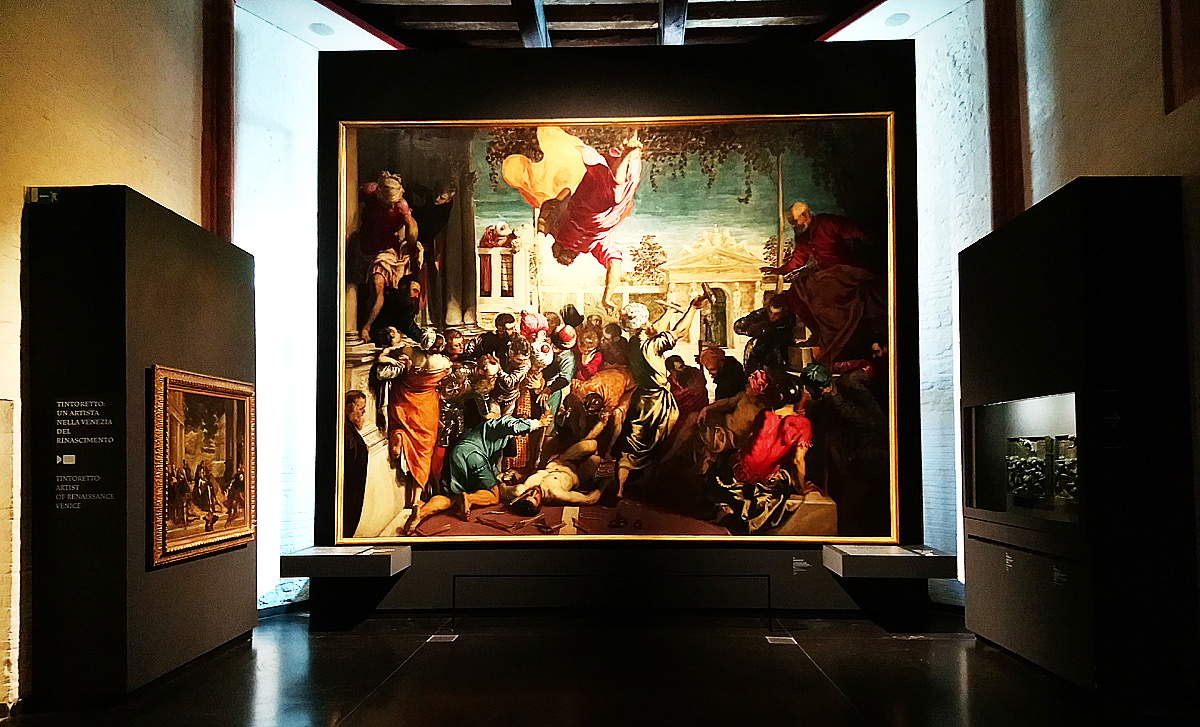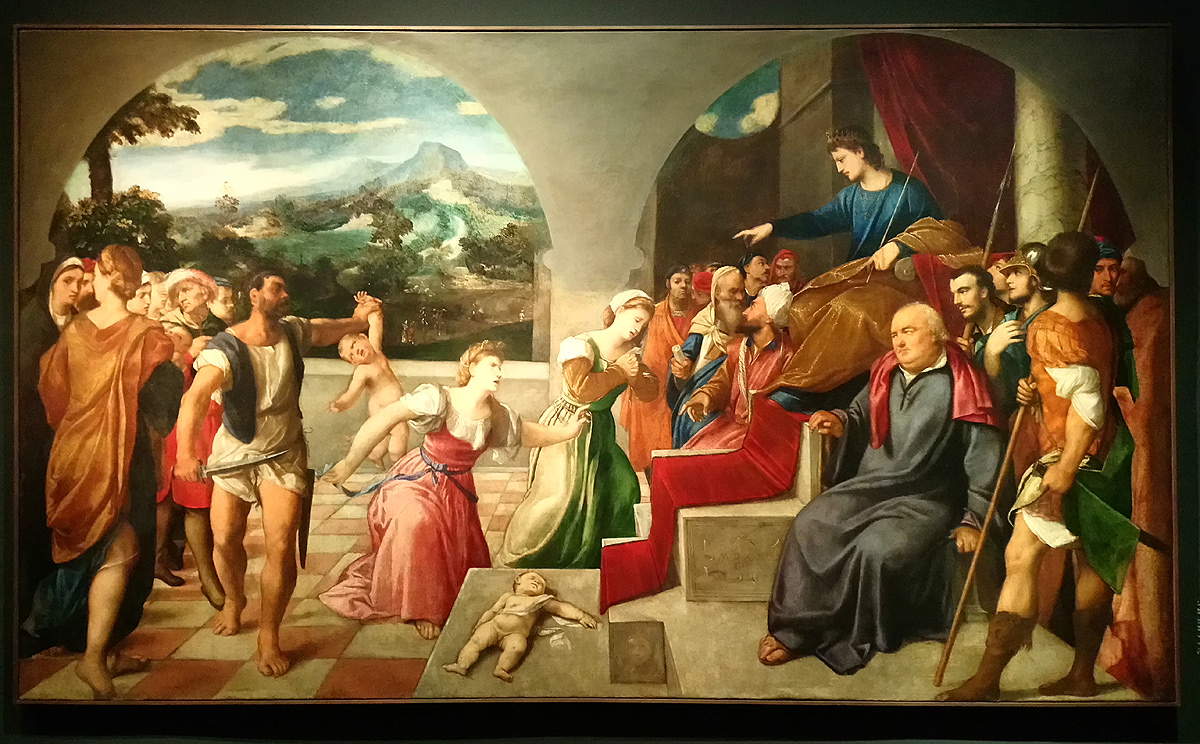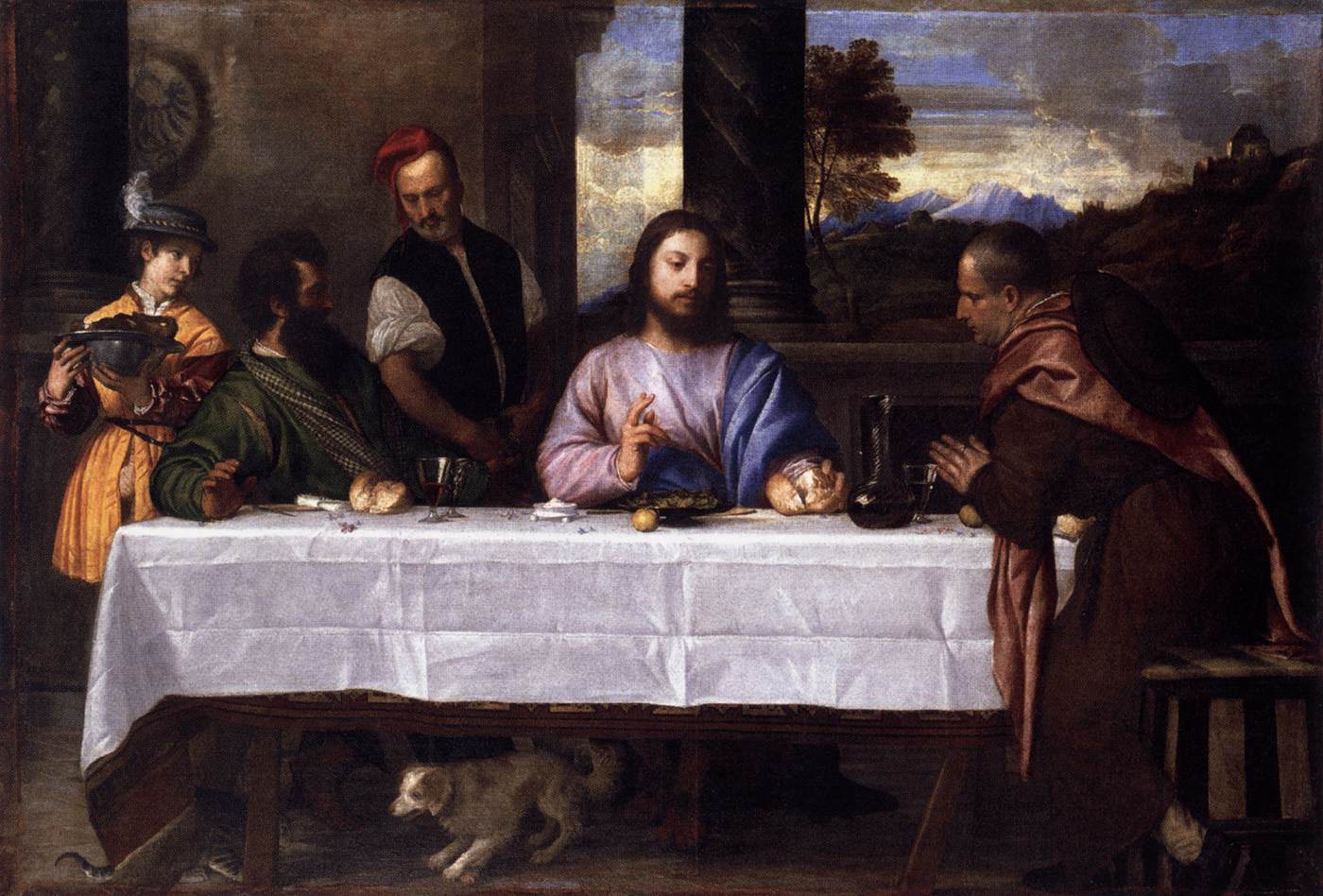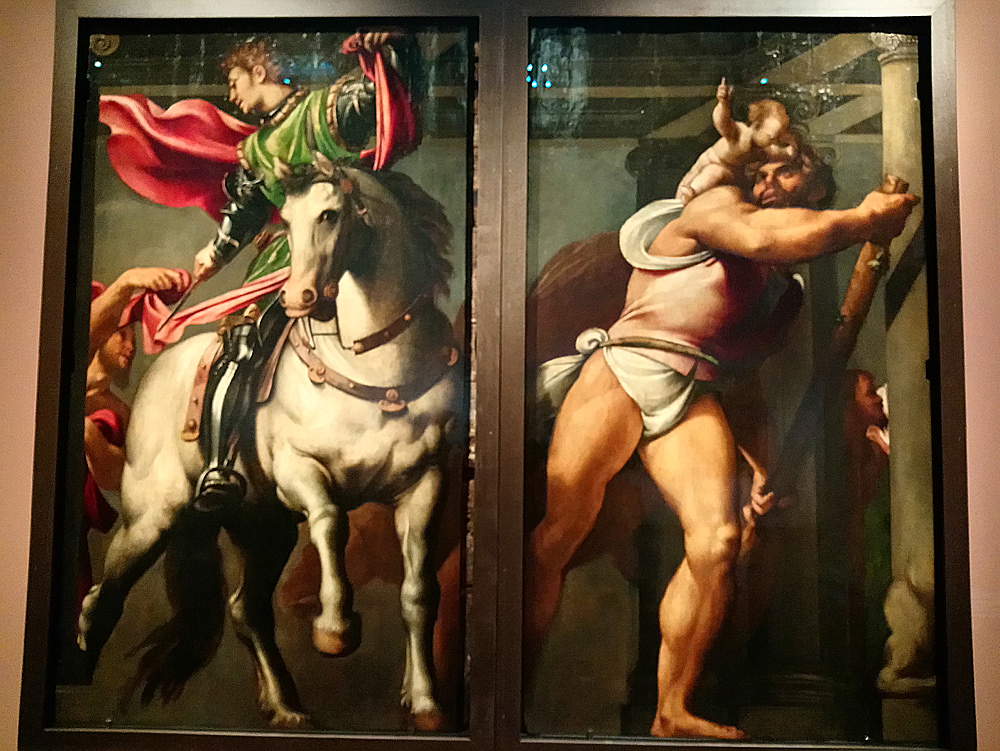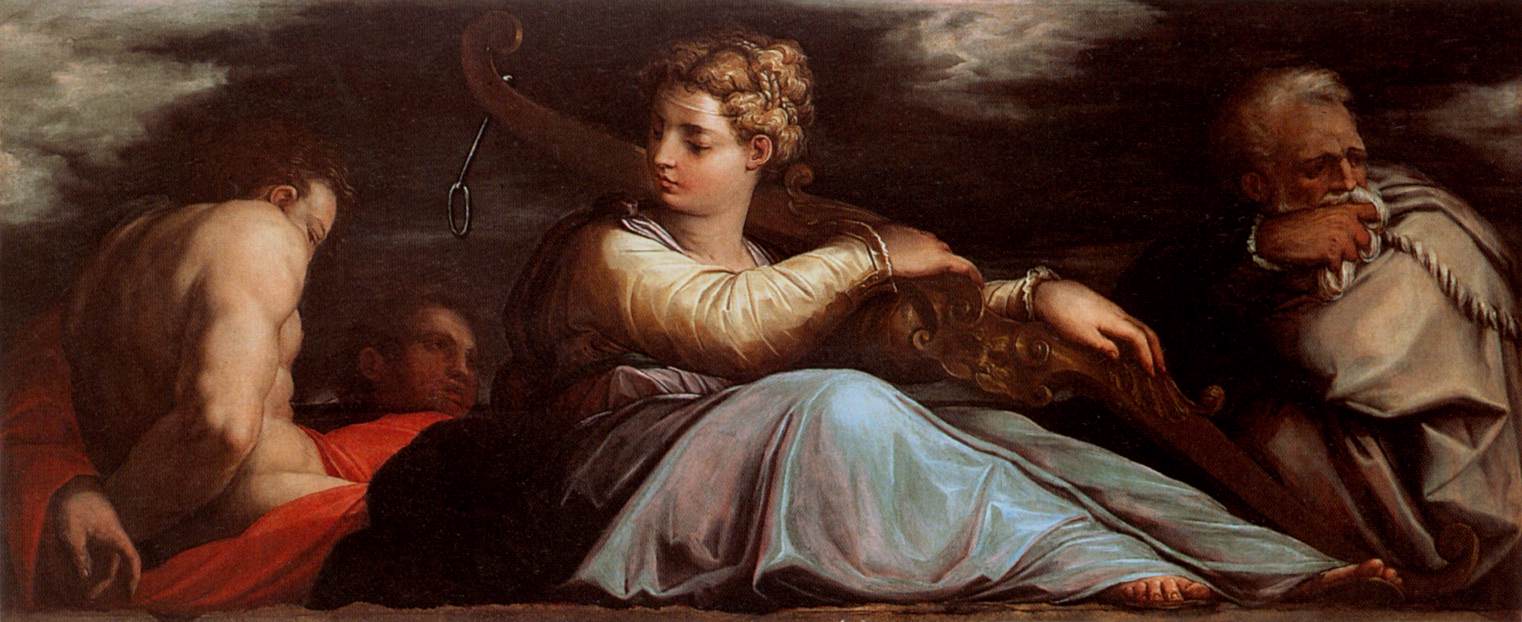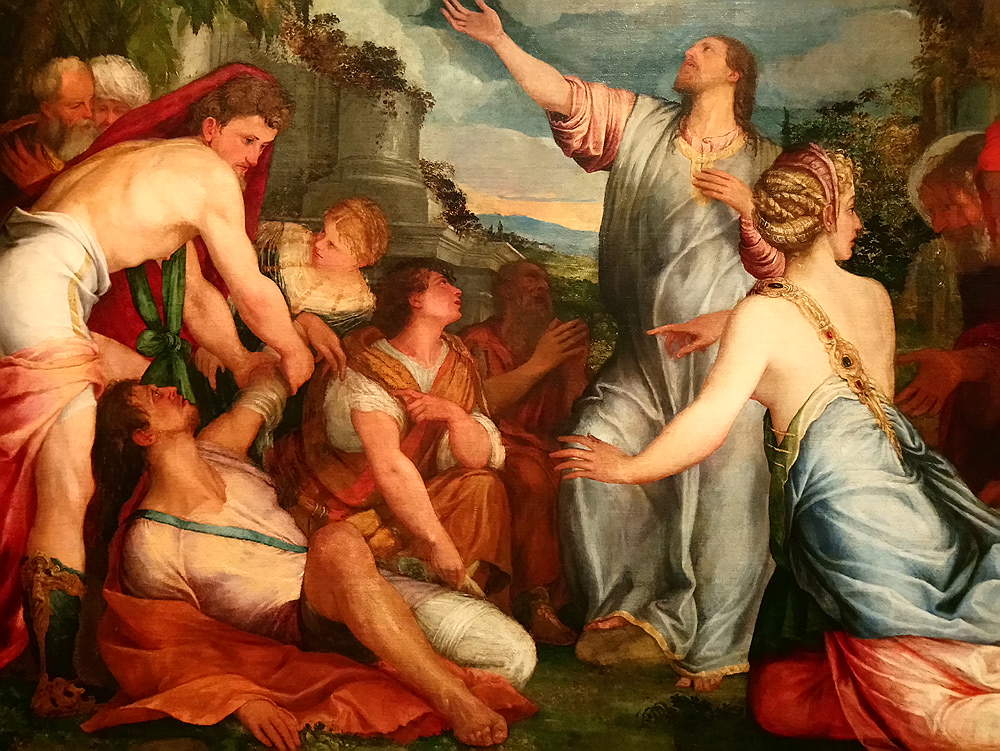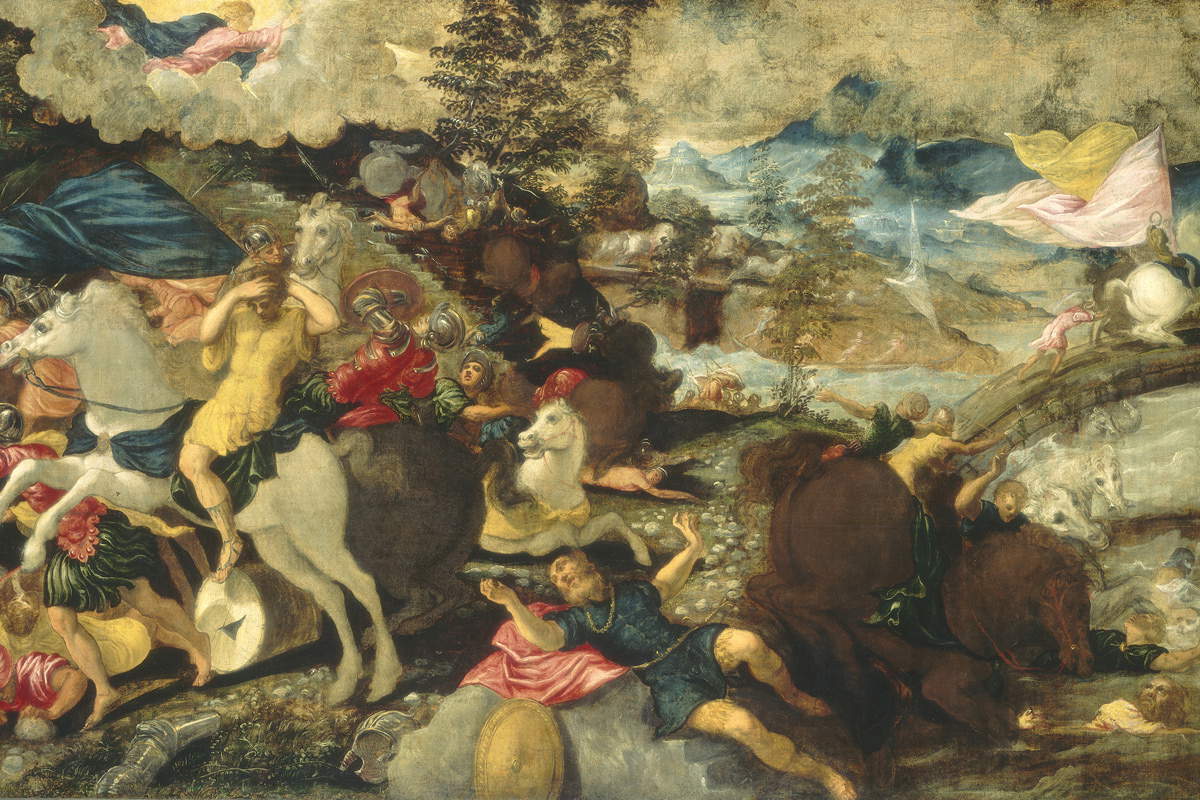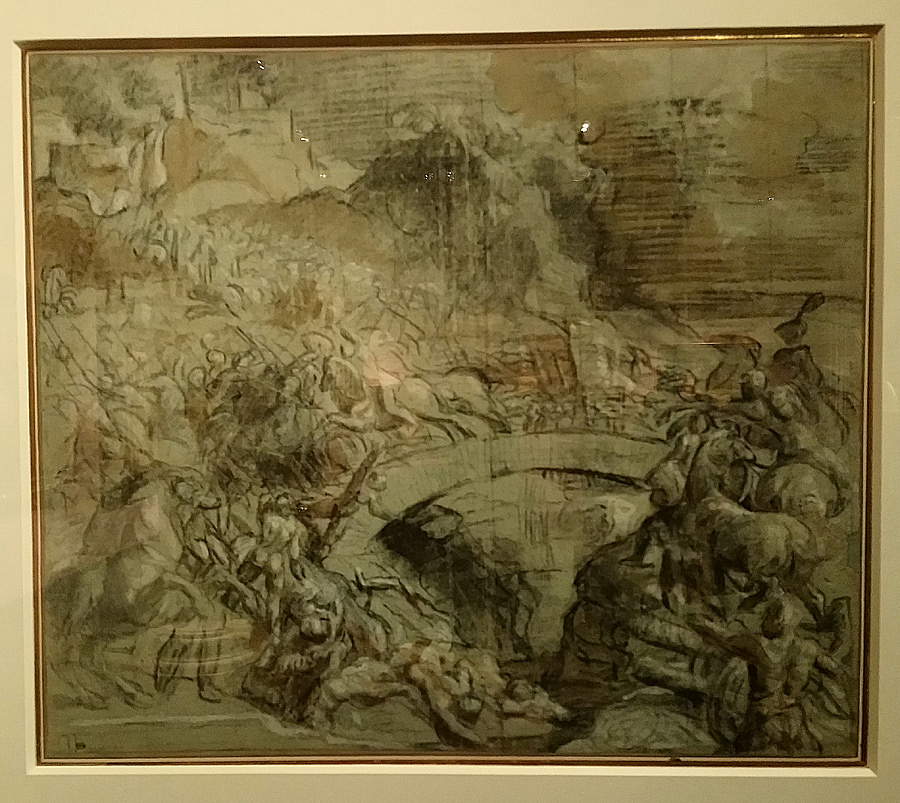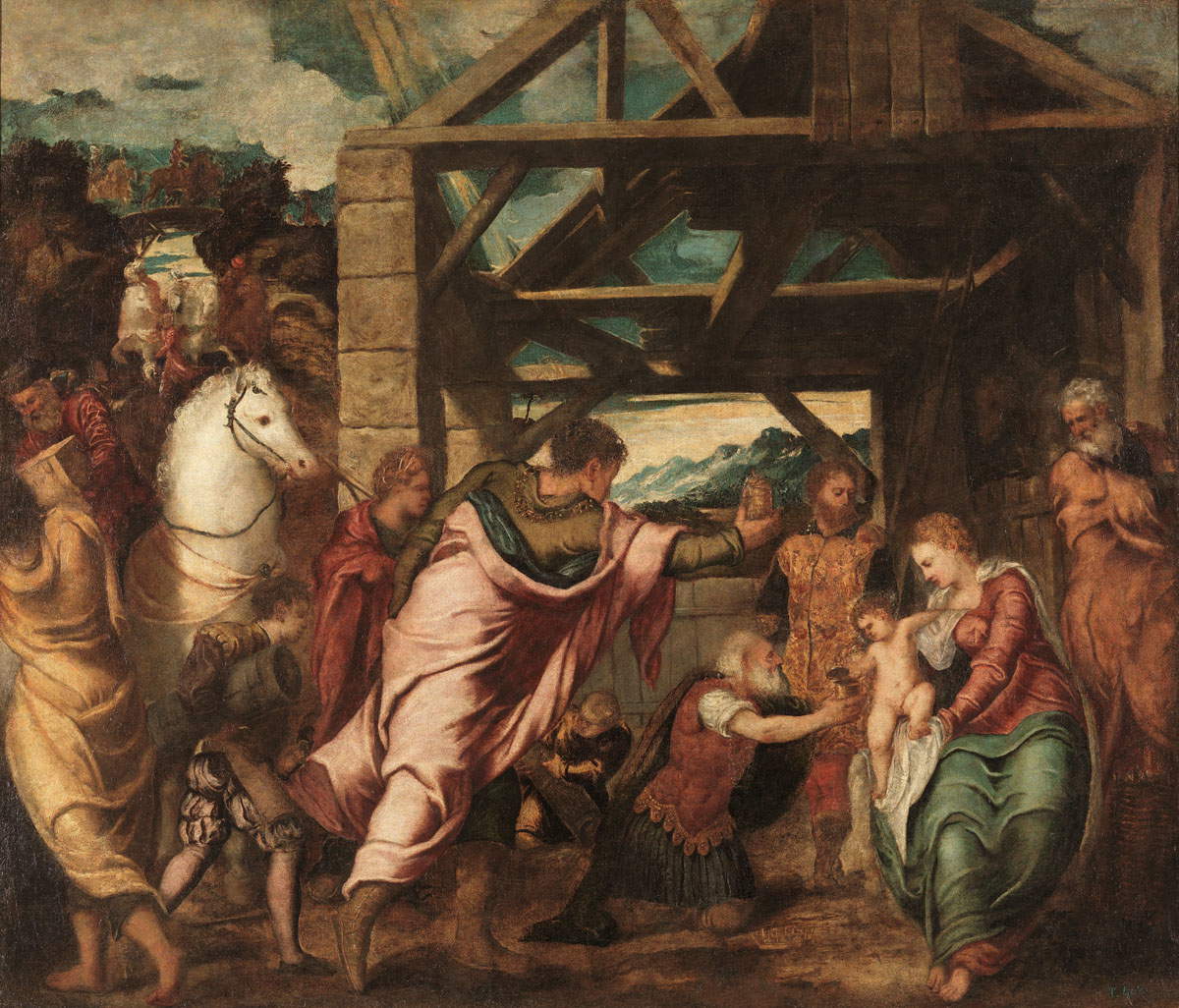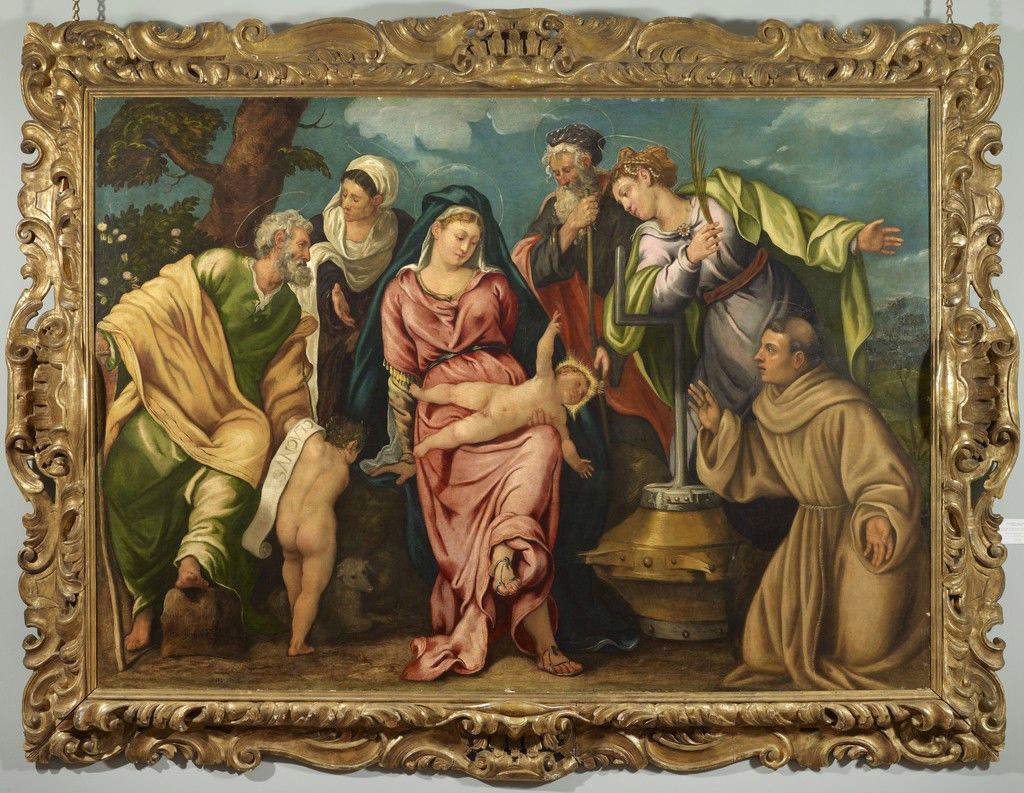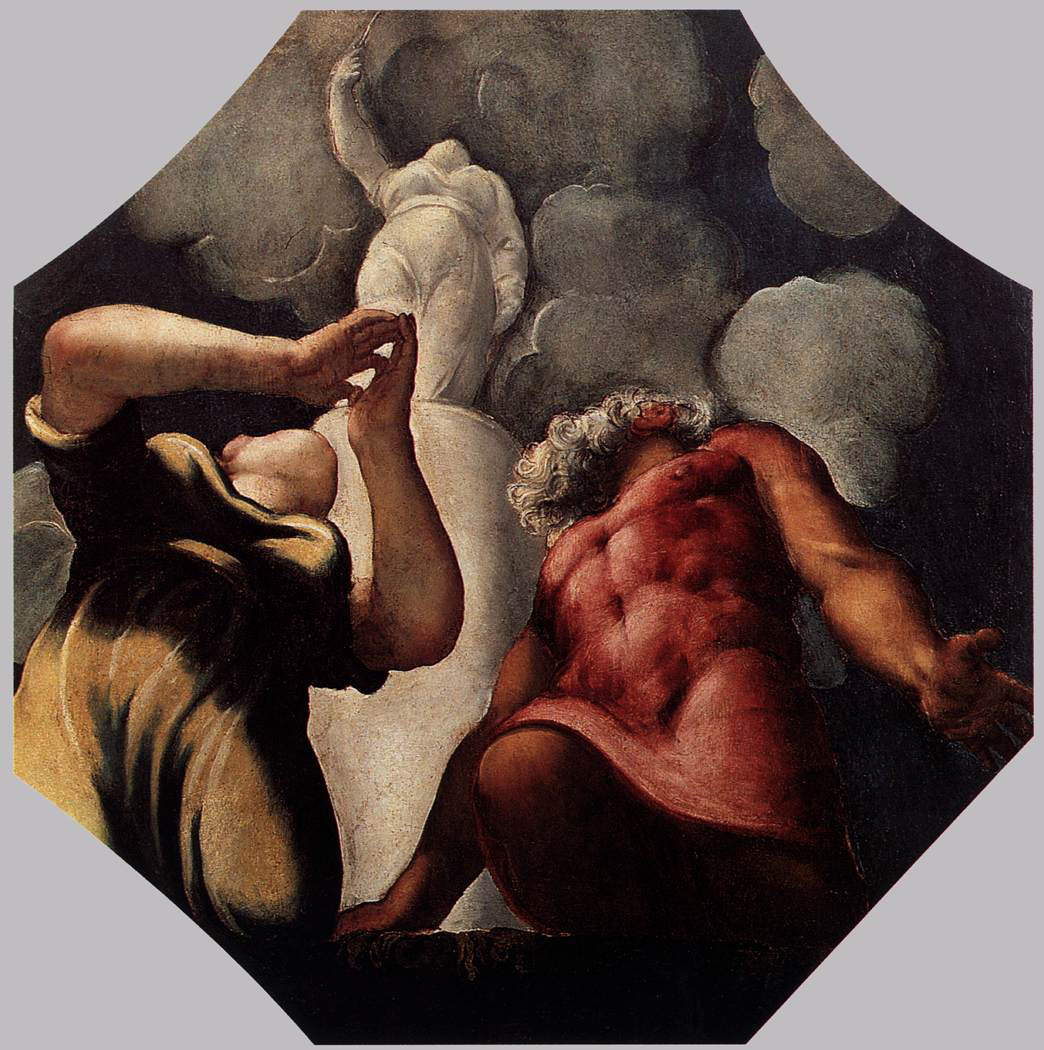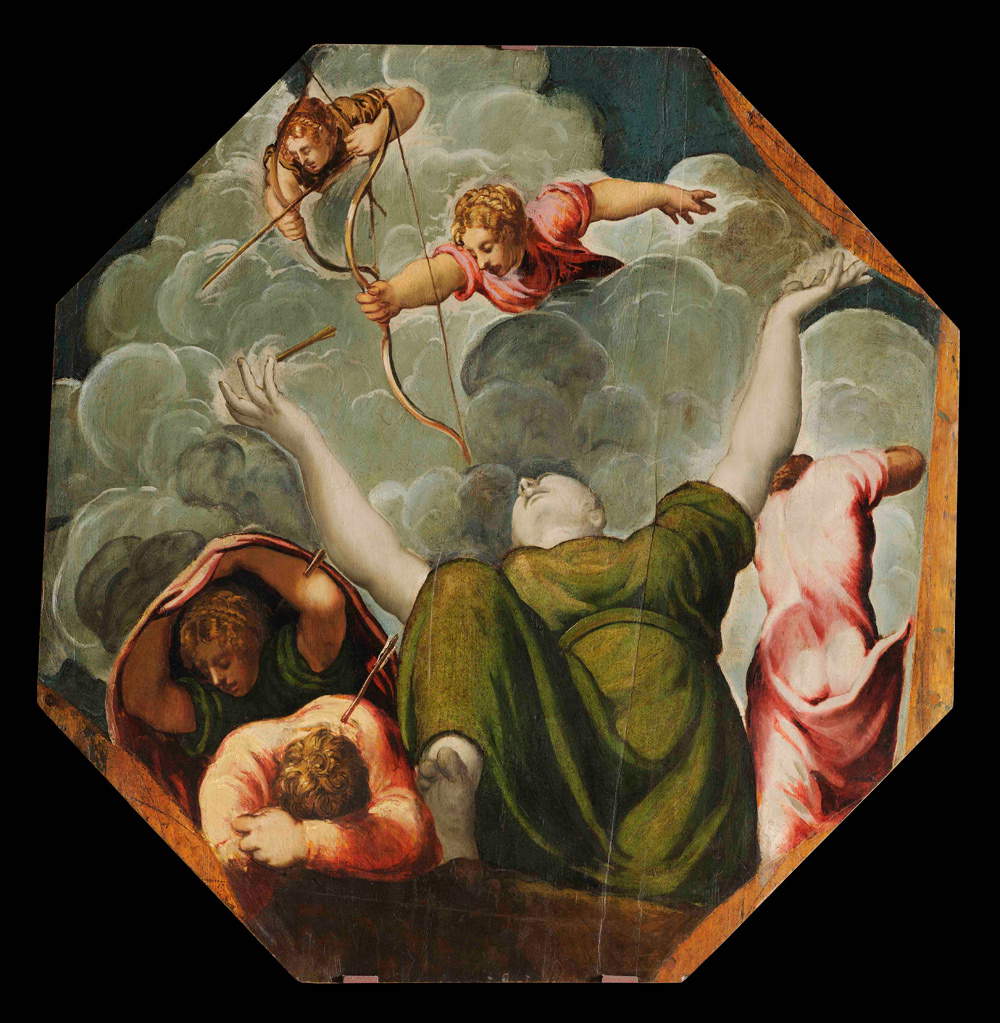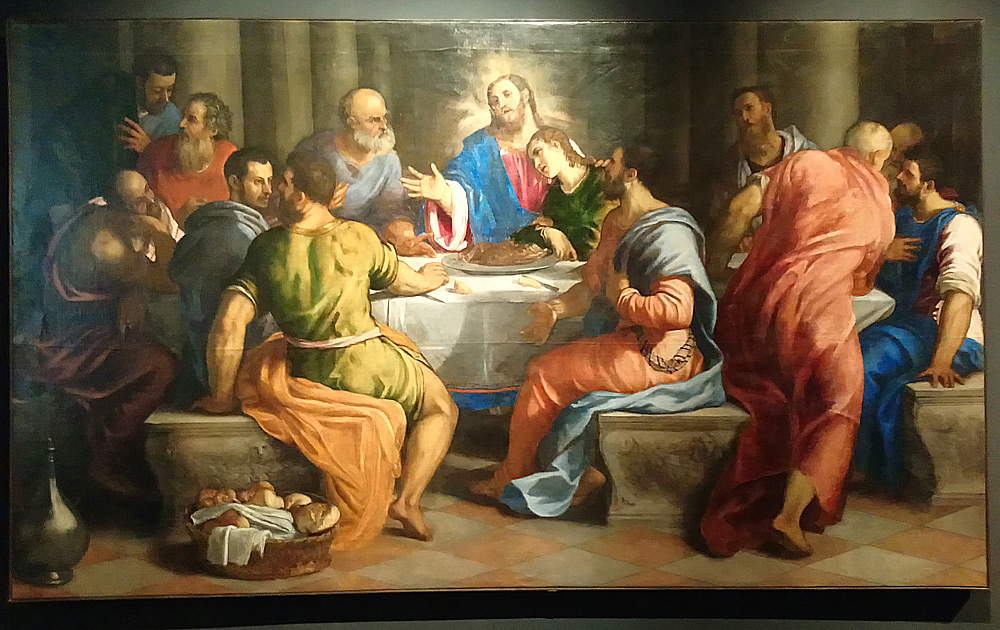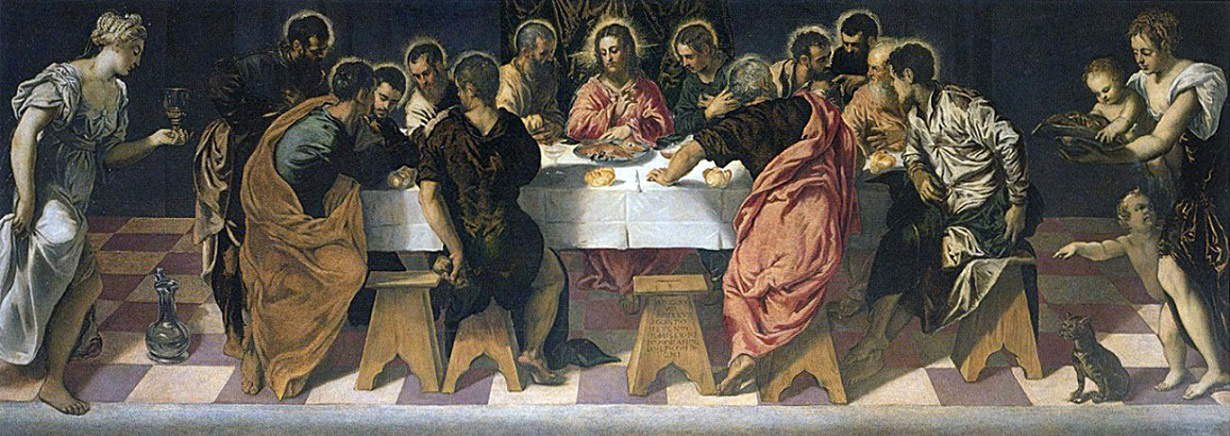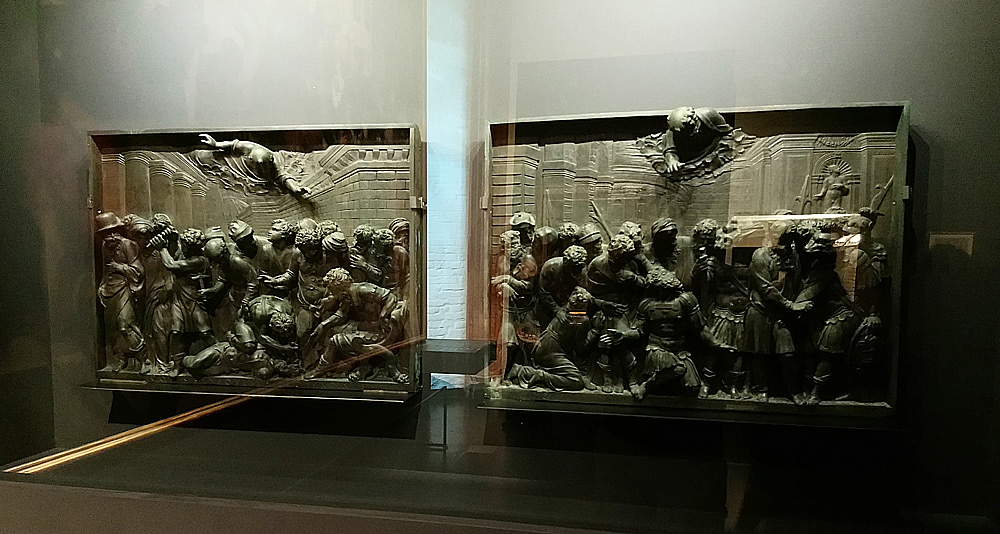by Ilaria Baratta , published on 02/12/2018
Categories: Exhibition reviews
/ Disclaimer
Review of the exhibition 'The Young Tintoretto,' in Venice, Gallerie dell'Accademia from Sept. 7, 2018 to Jan. 6, 2019
“Being much inclined by nature to drawing, he gave himself with great diligence to draw all good things at Vinegia, and made great study over the statues representing Mars, and Neptune by Jacopo Sansovino, and afterwards took for principal master the works of the divine Michelagnolo, not concerning himself at no expense for having formed his figures of the Sacristy of San Lorenzo and likewise all the good models of the best statues that are in Florence [...] but in coloring he says he has imitated nature, and then particularly Titian.” so wrote, in 1584, the scholar and art critic Raffaello Borghini (Florence, 1537 - 1588) about Jacopo Robusti known as Tintoretto (Venice, 1519 - 1594). Indeed, critics agree that a great role model for the Venetian artist was Michelangelo Buonarroti (Caprese, 1475 - Rome, 1564), although the answer to a precise question still remains uncertain: did Tintoretto ever personally and directly see Michelangelo’s masterpieces in Rome? According to Rodolfo Pallucchini (Milan, 1908 - Venice, 1989), a scholar fundamental to Tintoretto’s biography, since he devoted much of his working life to studying the latter, “it is very likely that the artist in the middle of the fifth decade went to Rome: perhaps in the same year as Titian,” but “tradition does not record such a trip.” Of the same opinion was Sydney J. Freedberg (Boston, 1914 - Washington, 1997), to whom it seemed impossible that the artist had been influenced by the art of other authors: taking into account the bursting Michelangelism that he had noticed in the young Tintoretto, he hypothesized a trip to Florence or Rome in 1540, in particular by comparing the Venetian artist’s Sacra Conversazione Molin , a work signed and dated 1540, with the statues in the Sacristy of San Lorenzo made by Michelangelo.
However, it is in fact in the large canvas of the Miracle of the Slave that the most significant cross-references to Buonarroti’s works have been discovered and studied: from the Pauline Chapel, to the Medici tombs, to the sculptural group of the Two Wrestlers left as a sketch, to the Final Judgement in the Sistine Chapel. The canvas was Tintoretto’s first public work intended for a prestigious Scuola Grande, namely that of St. Mark’s, and it was Pietro Aretino (Arezzo, 1492 - Venice, 1556) in a letter who assured that the masterpiece had already been completed inApril 1548, adding his praise: “Since the voice of the publica laude is confirmed with the proper one given you by me in the great painting of the istoria dedicated in the scola di San Marco, I rejoice no less with my judgment, which knows so far ahead, than I do with your art, which passes so far ahead. And just as there is no nose, however unbelieving it may be, that does not feel in some part the smoke of the incense, so there is no man so uninstructed in the virtue of drawing, that he is not amazed in the relief of the figure, which, all naked, down on the ground is offered to the cruelties of the martyr. Her colors are flesh, her features round, and her body alive, so that I swear to you for the good that I wish you, that the waxes, the airs, and the sights of the crowds that surround her, are so similar to the effects that they make in such a work, that the spectacle seems more true than false.” Between Pietro Aretino and the painter there was a relationship of patronage (he commissioned him to work at Palazzo Bolani) and high esteem (Tintoretto’s characteristic "prestezza" was considered by him to be a merit); it also seems that the artist portrayed Aretino himself in the aforementioned Miracle of the Slave, in the bearded man who emerges from the columns above the woman holding a child, on the left of the painting.
The large canvas of the Miracle of the Slave also represents a kind of watershed between Tintoretto’syouthful art and his more mature phase, which is why it has been placed at the conclusion of the exhibition The Young Tintoretto, the exhibition held at the Gallerie dell’Accademia in Venice until January 6, 2019. However, the work was also taken as the starting point of another exhibition dedicated to Tintoretto in the lagoon city, inside the Doge’s Palace. The second exhibition would thus be said to be a continuation of the first: in The Young Tintoretto, the aim is to outline the personal artistic path the painter undertook in order to reach the realization of his first public work destined for a very important institution in the first decade of his activity, while in Tintoretto 1519 - 1594 (this is the title of the exhibition at the Doge’s Palace) the most significant stages of his career are outlined, from the mid-1540s to 1594, the year of his death.
 |
| Hall of the exhibition The Young Tintoretto in Venice, Gallerie dell’Accademia |
 |
| Hall of the exhibition The Young Tintoretto in Venice, Gallerie dell’Accademia |
 |
| Hall of the exhibition The Young Tintoretto in Venice, Gallerie dell’Accademia |
 |
| Hall of the exhibition The Young Tintoretto in Venice, Gallerie dell’Accademia |
How did Tintoretto come to the execution of his first major masterpiece? What influences did he receive in the city of Venice? The answers to these questions are complex, as there is no coeval documentation of his training, only biographical accounts written a century later. This is the starting point from which the exhibition The Young Tintoretto takes off, which develops through paintings he made himself in the first decade of his artistic activity and others executed by his contemporaries who passed through the lagoon city.
Beginning in the 1630s, the Tuscan sculptor and architect Jacopo Sansovino (Florence, 1486 - Venice, 1570), the Bolognese architect Sebastiano Serlio (Bologna, before 1490 - Fontainebleau, c. 1554) and the man of letters Pietro Aretino arrived from central Italy, when Venice was ruled by Doge Andrea Gritti, between 1523 and 1538. Sansovino gave the city a Renaissance and old-fashioned layout, Serlio was responsible for drafting general rules of architecture dealing with the five “manners” of buildings, and Aretino maintained relations in order to promote local artistic culture. Under the influence of these figures, artists of the time working in Venice produced works that carried such novelties: Significant in this respect is the Consegna dell’anello al doge, a painting made by Paris Bordon (Treviso, 1500 - 1571) between 1533 and 1535 that depicts the concluding part of the fisherman’s legend, according to which on the night of February 25, 1340, a fisherman ferried Saints Nicholas, George and Mark to the Lido and witnessed the miracle that led to the end of the sea gale that was threatening the city; the painting (absent from the exhibition itinerary but visible in its usual location at the Gallerie dell’Accademia) depicts the moment when the fisherman hands over to Doge Bartolomeo Gradenigo the ring he received from St. Mark as a sign of protection toward the city. In the composition of the painting one can see the explicit influence of Sansovino and Serlio in their interest in architecture: a large scenography surrounds the event, and various elements are quotations from Serlio’s treatise on Renaissance architecture; the building in the background, on the other hand, recalls Sansovino’s design for the renovation of the Doge’s Palace wanted by Gritti.
Also highlighted in Bordon’s canvas is Titian ’s colorism, which Tintoretto himself took as a model: Titian (Pieve di Cadore, c. 1488/1490 - Venice, 1576) in fact belonged to that Venetian tradition based on color, which gave the painting a particular depth and intimacy, and on the introduction of naturalistic elements. Note the robes of the characters depicted in The Delivery of the Ring to the Doge, where color highlights the material of the fabrics: an aspect clearly visible in Titian’s own Supper at Emmaus, completed between 1533 and 1534 at the court of Federico II Gonzaga for the Mantuan nobleman Nicola Maffei. Or again in the Judgement of Solomon of 1533 by Bonifacio Veronese (Verona, 1487 - Venice, 1553), another Titian-educated artist: here Titian’s typical chromaticism with bright colors, naturalism and the presence of a landscape appearing beyond the architecture remain, but Raphaelesque compositional patterns are also introduced, such as the scaled frieze-like figures and groups of figures placed at the sides of the painting, which circulated in Venice through prints and drawings. Significantly influencing the young Tintoretto was also the Friulian Giovanni Antonio de’ Sacchis, known as Pordenone (Pordenone, c. 1483 - Ferrara, 1539), who made tangible in his works, or rather in his "terrible glimpses of figures," the deep connection with Michelangelo’s art, which the artist had been able to admire with his own eyes during a trip to Rome. On display are Saints Martin and Christopher, depicted painted in the ancient doors for thecupboard intended for the safekeeping of the treasure of the church of San Rocco: the saints occupy the entire space of the panels and seem to spill out with great burst and force; the bodies of the saints and of Saint Martin’s horse fully possess Michelangelo’s characteristic plasticism. Tintoretto himself from 1549 will create in the church of San Rocco the canvas depicting St. Roch visiting the plague victims, having well in mind the frescoes of the dome and choir painted by Pordenone in the same place. The choice of depicting monumental figures that leave little visibility to the landscape in the background, as in Pordenone’s glimpses, is an aspect present in the Holy Family (1539) by Polidoro da Lan ciano (Lanciano, c. 1510 - Venice, 1565), a painter who was influenced along with Bonifacio Veronese and Paris Bordon by the Titianesque lesson, as can be seen in the draperies of the characters.
In the early 1540s other artists brought new influences to Venice: Francesco Salviati (Florence, 1510 - Rome, 1563) and Giorgio Vasari (Arezzo, 1511 - Florence, 1574), Tuscans who exported traits of Tuscan-Roman and Emilian culture to the lagoon. The former, who arrived in Venice in July 1539, included in his works figures with elegant physiognomies reminiscent of those painted by Parmigianino (Parma, 1503 - Casalmaggiore, 1540). Exemplary is the altarpiece he made for the Camaldolese nuns of Bologna depicting the Madonna and Child enthroned among various saints, including St. Christine with an arrow stuck in her forehead, and kneeling at the bottom of the painting are the founder of the order Romuald and Blessed Lucia, abbess of the monastery of St. Christine of Settifonte; among the latter is a model of that monastery from which the nuns had moved in 1247. OfParmesan inspiration is the Madonna, with her elongated form, elegant face and hand brought forward holding the veil of the infant Jesus. The drapery of the Virgin and the pose of the Child standing on his mother’s knees will be found in Tintoretto’s Sacra Conversazione Molin , a painting that is also inspired by the Madonna of the Sacristy of San Lorenzo painted by Michelangelo. Giorgio Vasari stayed in the lagoon in April 1542, as he was commissioned to paint the ceiling of the Camera Nova in Palazzo Corner: the artist decorated it with allegorical subjects, but when the ceiling was demolished, the panels were dispersed. These include the Justice and Patience visible in the exhibition, which reappeared in various Venetian palaces and were later sold to the Gallerie dell’Accademia in 1987. The two figures are depicted in slight foreshortening: Justice is seen from behind with the code of law and sword, her attributes, and is placed in the center between two figures with lictor fasces and another wearing a crown identifiable as Solomon or Trajan; Patience, on the other hand, is seated in the center of the painting looking downward and appears serene under the weight of the yoke she holds on one shoulder. The man next to him has been identified as Job and was probably inspired by Michelangelo’s Jeremiah in the Sistine Chapel. Vasari was also supposed to decorate the ceiling of the church of Santo Spirito in Isola, but following his departure from Venice in 1542, the task was given to Titian. The latter created an illusionistic ceiling with scenes from theOld Testament and a cycle for theAlbergo Nuovo of the Scuola Grande di San Giovanni Evangelista: the centerpiece of that cycle was St. John the Evangelist on Patmos, which visitors can admire in the exhibition itinerary. The painting, housed at the National Gallery in Washington, depicts in a perspective from below the patron saint of the Scuola accompanied by his attributes, the eagle and the book, as he raises his arms to heaven in amazement after hearing the voice of God on the island of Patmos. In addition to Salviati and Vasari, young artists linked to Tuscan-Roman culture arrived: among them were Giuseppe Porta Salviati (Castelnuovo di Garfagnana, c. 1520 - Venice, 1575/1576), already in the Roman workshop of Francesco Salviati, from whom he took his pseudonym, and Lambert Sustris (Amsterdam, 1510/1515 - Venice, 1584). They provide insight into their art, through which they spread Tuscan-Roman culture to Venetian lands, their two works on display, respectively The Resurrection of Lazarus (c. 1543) and The Circle of Fraud (c. 1541-1542). In Venice the two artists worked on the decoration of important city palaces, such as the Palazzo del Capitanio, particularly the Sala dei Giganti, and the palace of the jurist Marco Mantova Benavides. Before delving into Tintoretto’s debut works, the exhibition analyzes a fundamental aspect of the dissemination of types and models to be used in paintings: in particular, the woodcuts illustrating Le Sorti, entitled Giardino di Pensieri, whose first edition was published in 1540, were significant; the signature of Giuseppe Porta appears on the frontispiece, but interventions by Francesco Salviati, Lambert Sustris, and Andrea Schiavone have been recognized. Also worth mentioning are Pietro Aretino’s Vita di Maria Vergine (1539) and Vita di Catherina Vergine (1541), which contain woodcuts of extraordinary elegance.
 |
| Paris Bordon, Delivery of the Ring to the Doge (1533-1535; oil on canvas, 370 x 300 cm; Venice, Gallerie dell’Accademia) |
 |
| Bonifacio Veronese, Judgement of Solomon (1533; oil on canvas, 180 x 309 cm; Venice, Gallerie dell’Accademia) |
 |
| Titian, Supper at Emmaus (1533-1534; oil on canvas, 160 x 244 cm; Paris, Louvre) |
 |
| Giovanni Antonio de’ Sacchis known as Pordenone, Saint Martin and Saint Christopher (c. 1527-1528; oil on panel, 247.4 x 147.4 cm; Venice, Scuola Grande di San Rocco) |
 |
| Polidoro da Lanciano, Holy Family with St. Catherine, St. John and two angels</em (c. 1539; oil on canvas, 152 x 205 cm; Berlin, Staatliche Museen) |
 |
| Giorgio Vasari, Allegory of Justice (1542; oil on panel, 78 x 180 cm; Venice, Gallerie dell’Accademia) |
 |
| Giorgio Vasari, Allegory of Patience (1542; oil on panel, 77 x 184 cm; Venice, Gallerie dell’Accademia) |
 |
| Titian, Saint John the Evangelist on Patmos (c. 1547; oil on canvas, 237.6 x 263 cm; Washington, National Gallery of Art) |
 |
| Giuseppe Porta Salviati, Resurrection of Lazarus (c. 1543; oil on panel, 162 x 264 cm; Venice, Giorgio Cini Foundation) |
 |
| Lambert Sustris, The Circle of Fraud (c. 1541-1542; oil on canvas, 155 x 356 cm; Florence, Fondazione di Studi di Storia dell’Arte Roberto Longhi) |
Between 1539 and 1540 Tintoretto produced a particular Conversion of St. Paul, now in the National Gallery in Washington: a subject popular with sixteenth-century artists because it allowed them to measure themselves against a battle scene. What is depicted by a young Tintoretto in his early days, trying to find his own style, is a disjointed battle in which confusion reigns. Aside from some unfinished elements, such as the waves or the head of the soldier on horseback on the bridge, critics have pointed out that the artist introduced figures into this work that harked back to other artists: the protagonist, Paul, falling from his horse is inspired by the Conversion of Saul in the cartoon by Raphael (Urbino, 1483 - Rome, 1520) for a Sistine Chapel tapestry; the battle and nature with superimpositions of men and animals could be traced back to a drawing by Francesco Salviati, handed down from an engraving by Enea Vico (Florence, 1523 - Ferrara, 1567). The white horse that seems to spill out of the left side of the canvas recalls Pordenone’s fresco for the facade of Palazzo Talenti, while the man submerged in water on the lower right is similar to one of the giants that Giulio Romano (Rome, c. 1499 - Mantua, 1546) depicted in Mantua in the Sala dei Giganti. However, a strong influence is believed to come from Titian’s Battaglia di Cadore, executed in 1538 for the Sala del Maggior Consiglio, a study of which is on display in the exhibition in an autograph sheet housed in the Louvre: in particular, the bridge, the water, the landscape in the distance, the arrival of the storm, and the bodies tumbling to the ground in a general downward thrust are noted in common. This last element creates an affinity with the left-hand side of theAdoration of the Magi, painted by Jacopo Robusti between 1538 and 1539, now in the Prado Museum; the bodies of the soldiers are indeed akin to the magi tumbling down from a valley on horseback or on foot with their gifts. Nothing remains of Titian’s original work: it was destroyed in thefire at the Doge’s Palace in Venice that broke out in 1577.
Tintoretto’sfirst dated work is the so-called Sacra Conversazione Molin, a name derived from theinscription on the stone in the lower left corner of the painting: “Jachobus” followed by a stylized mill-like wheel and the date, 1540. Among the various interpretations, one has thought of a painter named Jacopo Molin, Tintoretto’s alter ego, or the name of the Venetian patron Jacopo di Alvise dei Molin; in the latter case, however, the inscription would not refer to the artist’s signature, only to the date. The figures depicted on the canvas appear monumental in size and leave little of the surrounding landscape visible: a characteristic that Tintoretto takes from Pordenone, as mentioned above. At the center of the scene is the Madonna, reminiscent of the one in Michelangelo’s Medici Sacristy in the way she leans her arms against the rock and in the unbalancing of the figure, and she holds on her knees the Infant Jesus, who is placed in a soaring position toward St. Francis and St. Catherine; the latter is unbalanced forward and leans on the great wheel of martyrdom. In addition to Michelangelo’s Madonna, the Madonna of the Sacred Conversation Molin also bears affinities with the aforementioned Madonna and Child with Saints by Francesco Salviati executed for the church of Santa Cristina in Bologna, especially with regard to the drapery of her dress. Unlike the other characters depicted with a certain dynamism, the Saint Francis on the right side of the work appears static.
 |
| Tintoretto, Conversion of St. Paul (c. 1544 or 1539-1540; oil on canvas, 152.5 x 236.5 cm; Washington, National Gallery of Art) |
 |
| Titian, Study for the Battle of Cadore (c. 1537; charcoal and black pencil, brown watercolor, raised chalk and white watercolor on blue paper, reframed in black pencil, 383 x 442 mm; Paris, Louvre, Département des arts graphiques) |
 |
| Venetian painter of the second half of the 16th century (Leonardo Corona?), The Battle of Cadore, from Titian (before 1577; oil on canvas, 121 x 134 cm; Florence, Uffizi) |
 |
| Tintoretto, Adoration of the Magi (c. 1538-1539; oil on canvas, 174 x 203 cm; Madrid, Museo Nacional del Prado) |
 |
| Tintoretto, Madonna and Child between Saints James, Elizabeth, John, Zechariah, Catherine of Alexandria and Francis (1540; oil on canvas, 171.5 x 244 cm; Private Collection) |
Looking instead to Giulio Romano are the three octagons with mythological scenes, part of the sixteen paintings that decorated the ceiling of Palazzo Pisani in San Paternian. The three works, now part of the collections of the Galleria Estense in Modena, are indeed reminiscent of the decorations in the Psyche Room at Palazzo Te in Mantua, thus presupposing a possible trip to the Lombard city. Commissioned by Vettore Pisani presumably on the occasion of his marriage to Paolina Foscari, and the first in the long series of high-profile commissions the artist managed to obtain, the paintings depict Apollo and Daphne, the Slaughter of Niobe’s Children, and Deucalion and Pyrrha praying before the statue of the goddess Temi. The scenes are inspired by Ovid’s Metamorphoses, and their composition denotes the necessary bottom-up view in order to admire the glimpses of those muscular bodies from a proper perspective. However, reference to Vasari has also been seen in bringing the figures back to the surface and weaving linear interweavings, as in theApollo and Daphne, where both figures from behind are linked by a dynamic weave. Another painting, preserved at the Wadsworth Atheneum Museum of Art in Hartford, which Tintoretto completed for the ceiling of a room in the Venetian home of Pietro Aretino, is also on the subject of Ovid. Evidence of this is a letter the latter wrote to the painter in February 1545 to thank him for “the two instories, one in the fable of Apollo and Marsyas, and the other in the novella of Argos and Mercury” painted “in less space of time than you put in thinking about what you had to paint in the palco de la camera.” Aretino again emphasizes the painter’s “prestezza.” It is exhibited as a loose painting La contesa tra Apollo e Marsia (The Struggle between Apollo and Marsyas), which is very different, though similarly intended for the ceiling, from the previous octagons: in fact, here the composition is not based on glimpses of figures from below in the Pordenone style, but rather on aTuscan and Salviatesque setting. On the left side Apollo with an arm lyre and Marsyas with a shawm-like instrument play before three bearded judges under the supervision of Minerva.
Closer to Bonifacio Veronese’s art and Tuscan-Roman culture is Budapest’s Supper at Emmaus, painted about 1543: However, Tintoretto added a more pathetic feeling, a dramatic tension now in full motion and his characteristic colors, playing also with the light that strongly illuminates the white tablecloth and the blue robe of one of the servants. The scene also plays on diagonals: note the pilgrims’ staffs, the inn sign, and the table set at an angle; Christ is concentrated and pensive in the blessing of the bread, while all the other characters crowding the scene, the pilgrims and the four servants, are depicted in motion. One could place alongside this work Giuseppe Porta Salviati ’sLast Supper, executed between 1545 and 1547 for the refectory of the monastery of Santo Spirito in Isola, in which we find figures from the back or three-quarter view in moving poses, bright colors of the draperies and a renewed plasticism of the bodies. The composition built on diagonals reaches a later stage of higher levels in the Dispute of Jesus in the Temple preserved in the Museo del Duomo in Milan. Thanks to perspective, the painter depicts on the right a sequence of doctors using dynamic and fast strokes and gives the large painting an extraordinary depth: a reason for which architectural studies from central Italy proved essential. The figures on the sides in the foreground reveal the strong Michelangelo influence, so these appear monumental, and in particular the young woman standing on the left refers to the Sibyls of the Sistine Chapel. Also peculiar is the fact that the latter is the only one listening to Jesus’ words amid the total indifference and inattention of the doctors. Prior to the Dispute, the artist sets another work on the use of diagonals: this is the Holy Family with the procurator Girolamo Marcello swearing in the hands of St. Mark, circa 1545. The monumentality of the Pordenone-esque figure of St. Mark on the right creates a scene organized along asharp diagonal; the Child in the arms of the Virgin leaps up to point to the page of the Gospel, while in a lower position appears Procurator Marcello, who is influenced by traditional Titian portraiture.
 |
| Tintoretto, Apollo and Daphne (c. 1542; oil on panel, 153 x 133 cm; Modena, Gallerie Estensi) |
 |
| Tintoretto, Deucalion and Pyrrha praying before the statue of the goddess Temi (c. 1542; oil on panel, 127 x 124 cm; Modena, Estensi Galleries) |
 |
| Tintoretto, Massacre of the Children of Niobe (c. 1542; oil on panel, 127 x 124 cm; Modena, Estense Galleries) |
 |
| Tintoretto, The Contest between Apollo and Marsyas (1544-1545; oil on canvas, 140.5 x 239 cm; Hartford, Wadsworth Atheneum Museum of Art) |
 |
| Tintoretto, Supper at Emmaus (c. 1543; oil on canvas, 156 x 212 cm; Budapest, Szépm?vészeti Múzeum) |
 |
| Tintoretto, Dispute of Jesus in the Temple (1545-1546; oil on canvas, 197 x 319 cm; Milan, Museo del Duomo) |
 |
| Tintoretto, Holy Family with Procurator Girolamo Marcello Swearing in the Hands of Saint Mark (c. 1545; oil on canvas, 148 x 193 cm; Private Collection) |
With the last section we reach the climax of the exhibition itinerary: the visitor is projected to the opposite wall of the room, on which the large canvas of the Miracle of the Slave has been placed, which, as mentioned, marks the end of The Young Tintoretto and the artist’s true public affirmation on the Venetian scene. In addition to the celebrated work, however, we have for the first time the opportunity to see three paintings of the same subject, namely TheLast Supper, brought together by artists who in the same years depicted the scene using different styles: Tintoretto’s one for the Scuola del Santissimo Sacramento in San Marcuola, dated August 27, 1547; Jacopo Bassano ’s (Bassano del Grappa, 1515/1516 - 1592), preserved in the Galleria Borghese, which was commissioned in 1546 by the Venetian nobleman Battista Erizzo and was welded by March 1548; and Giuseppe Porta Salviati ’s for the refectory of Santo Spirito in Isola, now in the church of Santa Maria della Salute. Porta Salviati’s version is still influenced by central Italian models with Salviatesque and Parmigianesque cues, but it is also greatly influenced by Titian colorism and furthermore the figures appear painted in motion. In Jacopo Bassano ’sLast Supper , the space becomes claustrophobic, crowded by the apostles depicted with a strong naturalism and accentuated gestures. Christ, turning his gaze toward the viewer, points to himself and the sacrificed lamb; all around the other numerous figures talk and discuss among themselves. On the white tablecloth appear bread, wine, fruit, knives, and, in the bottom center, the flask and basin are depicted, alluding to the washing of the feet: great naturalism stands out in each element. The hues used are cold with tones of green, purple, pink and blue. Tintoretto’s is an excited scene, dominated by intense expressiveness with dynamic and complicated gestures and poses. The characters are all gathered around the table in the center of the painting, some seated, others standing; the focus is Christ, and the apostles form small, almost symmetrical groups. On either side of the work, two young women are proceeding toward the table: the one on the left holds a chalice of wine, the one on the right holds a tray with food and is accompanied by two children, one of whom is carrying and the other walking attached to the woman’s robe. These have been interpreted as Faith and Charity. At the bottom in the center of the painting a blank space was left probably because it would have provided a neutral background for Christ placed on the Sacrament pew; in fact, the work may have been placed on the wall above the pew. The light constitutes a significant element: coming from the left, it illuminates only some parts of the characters, leaving others in shadow. This creates a play of light and shadow that will become typical in Tintoretto’s art: this is also noticeable to a lesser degree in Bassano’sLast Supper, particularly in the heads of the apostles: an aspect that indicates a relationship between the two artists and their respective works.
Arriving in front of the huge painting of the Miracle of the Slave, one immediately gets the impression of a crowded and somewhat dynamic scene: the most striking detail is the upside-down position of St. Mark, who descends from above head first onto the scene, and the artist portrays him suspended, stopping his movement as if in asnapshot. The scene depicted concerns one of the saint’s posthumous miracles : a lord of Provence inflicted torture on a slave because the latter had gone to venerate St. Mark’s relics against his master’s wishes. In fact, one can see the lord of Provence seated on a throne at the right end of the canvas and the naked body on the ground of the slave undergoing various tortures by his torturers. But the torture is suddenly interrupted by the appearance of the saint, who soars from above over the crowd of onlookers and causes the instruments of martyrdom to break: clearly visible is the hammer broken into two parts in the hands of the figure depicted standing with a turban on his head and a robe in shades of green, as well as other instruments scattered on the ground. The crowd of onlookers is made up of people of various social backgrounds and geographical origins: in fact, exotic clothes are mixed with 16th-century Venetian attire. There are those who lean out from the colonnade on the left, those who gaze in amazement at the scene with their gaze turned toward the slave, all with Mannerist-style twisting movements. Note the young woman with a baby in her arms, leaning against the base of the loggia, arching her back to get a better view of the scene: a female figure reminiscent of Raphael’s Expulsion of Heliodorus from the Temple. Michelangelo also used to highlight certain parts of the body to create more anatomical expressiveness. Further references to Michelangelo’s art can be found in the figures at the foot of the throne, born from studies of the models in the Medici Sacristy and based on the sculptural group of the Two Wrestlers that remained in sketch form, but especially in thevertical axis that binds the saint to the slave. This is an aspect already proposed by Buonarroti in the Pauline Chapel’s Conversion of Saul , a work dated 1542-43: here, too, the saint glides over the scene below, but that axis is made tangible by the vertical beam of light that binds precisely the two subjects; Tintoretto instead reduces the spatial distance between the two, creating contrast between the shadowed body of the saint and the illuminated body of the slave. Moreover, this varied repertoire of bodies whose poses are interlocking certainly harkens back to the Last Judgment in the Sistine Chapel.
The Miracle of the S lave was presumably preceded by a sketch depicting The Saving of the Body of Saint Mark (c. 1547), now preserved in Brussels. At the outbreak of a thunderstorm, the body of St. Mark after his martyrdom immediately is brought to safety before the pagans burn it. Because of the composition of the scene, the naked body on the ground illuminated by a beam of light, and the architecture present, the painting has been hypothesized to be an early proof of the large canvas of 1548 intended for the Scuola Grande di San Marco. The theme of the Miracle of the Slave had also been proposed by Sansovino in his reliefs of the choir loft of the Basilica marciana between 1541 and 1544, shown here in the exhibition. A dialogue is thus created around the Miracle of the Slave between the aforementioned sketch, which probably predates the work, and the bronze reliefs produced by one of those artists whose arrival in Venice influenced Tintoretto’s early production.
 |
| Giuseppe Porta Salviati, Last Supper (1545-1547; oil on canvas, 230 x 395 cm; Venice, Santa Maria della Salute) |
 |
| Jacopo Bassano, Last Supper (1547-1548; oil on canvas, 168 x 270 cm; Rome, Galleria Borghese) |
 |
| Tintoretto, Last Supper (1547; oil on canvas, 157 x 433 cm; Venice, San Marcuola) |
 |
| Jacopo Sansovino, Miracle of the Slave and Conversion of the Lord of Provence or Miracle of the Soldier in Lombardy (both 1541-1544; bronze, 48.5 x 65.8 cm; Venice, Basilica di San Marco) |
 |
| Jacopo Sansovino, Miracle of the Slave |
 |
| Tintoretto, St. Mark frees slave from torture, also called Miracle of the S lave (1548; oil on canvas, 415 x 541 cm; Venice, Gallerie dell’Accademia) |
The Young Tintoretto turns out to be a well-structured exhibition (of particular value are the comparisons with coeval artists, which allow for an effective contextualization of the beginnings of his art, reconstructed with great precision) to make comprehensible all the artistic and cultural steps that led the young artist to become one of the most significant painters of his Venice: as a self-taught artist he followed the different trends that followed one another in his land to arrive at his own way of painting, rising toartistic affirmation. And to continue the knowledge of his art, visitors need only go to the Doge’s Palace.
Warning: the translation into English of the original Italian article was created using automatic tools.
We undertake to review all articles, but we do not guarantee the total absence of inaccuracies in the translation due to the program. You can
find the original by clicking on the ITA button. If you find any mistake,please contact us.
